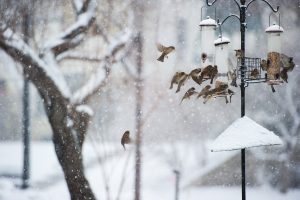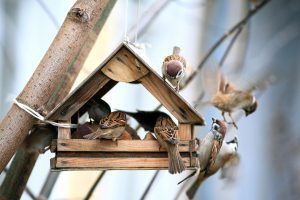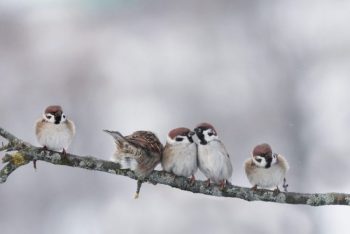Winter Safe Spaces for Backyard Birds: Houses, Feeders, Baths
How to choose and maintain winter resources for winter birds
When elementary students study the four seasons, they learn that birds migrate to warmer climates when the temperature dips in autumn. While many of our feathered friends do travel thousands of miles to escape the worst of winter, lots of hardy birds stick around. If you want to attract a lively mixed flock of wild winter birds to your yard, give them a little habitat.
Birds need food, water, and shelter every day.
They can generally find what they need in nature, but if you provide it for them, they will reward you by making your yard a much more interesting place. Winter birds especially like high-energy foods such as sunflower seeds, safflower seeds, peanuts, cracked corn, suet, and dried mealworms. They need a reliable source of clean fresh water that is not frozen. And, they need a place to sleep that is sheltered from harsh winds and safe from predators.

Food
Choose a feeder that works with the kinds of bird food you feed, and for the birds that feed in your yard. Hang a suet feeder on a pole or tree branch for chickadees, nuthatches, titmice, and woodpeckers to enjoy. Multi-port tube feeders attract smaller birds, like finches, chickadees, and titmice. Hopper feeders hold several pounds of food, and allow both small birds and large birds like cardinals, bluejays, and grackles to get in on the action. Ground feeding birds such as mourning doves, towhees, sparrows, and juncos will use seed tables, which elevate food off the ground and keep it from spoiling quickly.
In winter, high-energy bird food is best. Most feeder birds prefer a mix of black oil sunflower seed, safflower seed, cracked corn, and peanuts, but they don’t really eat much millet. Ground feeding birds enjoy millet, cracked corn, and sunflower hearts, but in-shell sunflower seeds may go to waste. Finches especially enjoy Nyjer (thistle) seed, which must be fed from either a specially designed tube feeder or a seed sock due to the tiny size of the seeds. Carnivorous birds like bluebirds, wrens, robins, and woodpeckers also enjoy the occasional treat of dried mealworms.

Water
Water is often overlooked in the winter, but birds need a steady supply even in freezing weather. If there is snow on the ground, they can use it, but they burn more calories in doing so. Unfortunately, fountains are susceptible to freeze damage, and not all birdbaths are built to withstand the cold. Providing liquid water can be a challenge, but where the weather stays cold, birds suffer without it.
Use an all-weather plastic or glazed earthenware birdbath that will not crack if the water freezes. Another inexpensive option is a heavy-duty plastic plant saucer. Locate it in a sunny, sheltered area. Keep the water in its liquid form by placing black stones or a circle of black plastic in the bottom of the basin to attract solar heat. Use a solar powered water wiggler, or an electric bird bath water heater for even more cold resistance. Change the water frequently, and clean the basin regularly to avoid spreading germs.

Shelter
Your yard may already have a variety of plants that provide some degree of shelter from harsh weather. Winter birds prize landscapes with early morning sunshine and dense evergreen foliage of trees, shrubs, and even the dormant foliage of ornamental grasses. Although birds do not nest and raise young in winter, cavity nesters like bluebirds, chickadees, woodpeckers, and others do use nest boxes or roost boxes throughout the winter for added protection from foul weather and predators. Clean out old nests at the end of summer to make way for winter users.
Roost boxes are much larger than nest boxes, as they are built to accommodate a small flock of adults. They are built with the entry hole at the bottom, and perches in the upper portion so that warm air will remain inside. Mount the box high on a pole in an area that has southern exposure and protection from prevailing winds. Install a baffle beneath the box to guard against predators.
By providing a hearty meal, a drink of water, and a cozy place to rest, you can build a backyard oasis that birds will flock to. In the most severe weather and scarcity of food, your efforts may even make the difference in their ability to survive. They’ll appreciate your effort, and you’ll be rewarded with lively, colorful visitors to your winter landscape.


You must be logged in to post a comment.